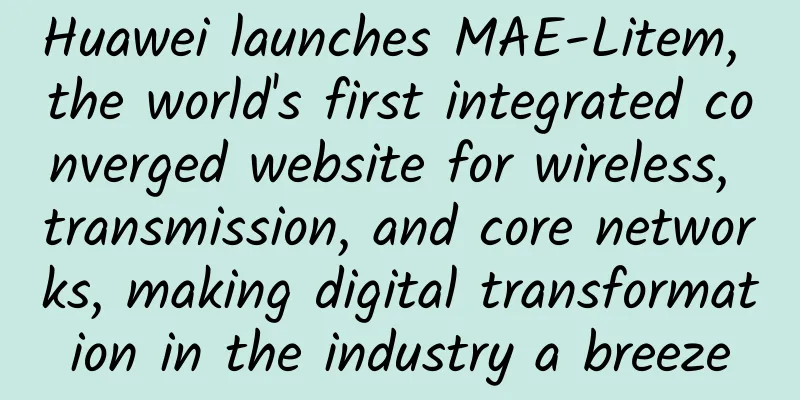What exactly is UWB technology?

|
This article is reprinted from the WeChat public account "Xianzao Classroom", the author is Xiaozaojun. Please contact the WeChat public account of Xianzao Classroom to reprint this article. Yesterday, Xiaomi executive Zeng Xuezhong officially released the "One-Finger Connection" UWB technology through Weibo, which attracted widespread attention from the entire network. According to the introduction, based on this "one-finger connection" technology, mobile phones and smart devices will have spatial perception capabilities, just like "indoor GPS". When the mobile phone points to the smart device, the control card will automatically pop up and can be directly controlled. Point your phone at the fan and a quick control card will pop up, turning on the fan with one click Point your phone at the TV and it becomes a TV remote control. You can also cast the screen with one click. I have to say that Xiaomi's marketing ability is really strong. A not-so-new technology was packaged and named, and it was promoted as the world's first product. (Don't criticize me, I'm also a Mi fan) That’s right, this UWB is the UWB that Apple launched simultaneously when it released the iPhone 11 on September 11 last year. At that time, the entire iPhone 11 series was equipped with the U1 chip that supported UWB technology. Apple has said that the U1 chip will significantly enhance the spatial awareness capabilities of the iPhone. Apple has also demonstrated fast file sharing based on UWB technology through the Airdrop application. Just last month, at Apple's fall conference, it was revealed that Apple's Apple Watch Series 6 will be equipped with a U1 chip and an ultra-wideband antenna to achieve spatial perception capabilities. So the question is, what is spatial perception? What exactly is UWB technology? In addition to spatial perception, what else can UWB do? Through this article, Xiaozaojun will reveal the answers to these questions for you one by one. What is spatial perception? The so-called spatial perception ability is the ability to perceive direction. More directly, it is the positioning ability. To put it simply, using UWB technology, mobile phones and smart devices can achieve indoor positioning more accurately, not only sensing their own location, but also the location of other mobile phones or devices around them. Xiaomi's spatial perception Centimeter-level positioning capability Speaking of positioning, I believe everyone is familiar with it. We often use apps such as Baidu Maps, which have positioning and navigation services. Positioning services help us understand location information, indicate directions, increase our sense of security and control, and bring great convenience to our work and life.
So, what is the difference between UWB technology and the positioning technology we commonly use now? The positioning technology we most commonly use now is satellite positioning. Satellite positioning is a technology that uses artificial satellites to measure points. Its characteristics are very obvious, that is, high accuracy, high speed and low cost.
The well-known GPS and Beidou belong to the Global Navigation Satellite System (GNSS), which can provide satellite positioning services. (Extended reading: What is the GNSS technology behind Beidou?) In order to better eliminate errors and improve response speed, GNSS will introduce some space-based or land-based auxiliary means. GNSS combined with auxiliary means is also called A-GNSS. A stands for Assisted. A-GNSS, which is more commonly used now, transmits enhanced correction data through land-based mobile communication networks, provides auxiliary information, strengthens and accelerates the search and tracking performance and speed of satellite navigation signals, shortens positioning time, and improves positioning accuracy. A-GNSS System Architecture Both GNSS and A-GNSS have an obvious disadvantage, which is that they cannot achieve indoor positioning. The reason is obvious, satellite signals will be blocked by buildings. However, with the development of the times, there are more and more business scenarios for indoor positioning, and users have a stronger demand for indoor positioning. For example, underground garage navigation, finding stores or companions in shopping malls, and even finding lost children. Therefore, some people began to try to use various short-range communication technologies to develop high-precision indoor positioning systems to meet user needs and make a little money. The available technologies include Wi-Fi, Bluetooth, UWB, etc. What is UWB Everyone is familiar with Wi-Fi and Bluetooth. What is UWB? UWB, which stands for Ultra Wideband, is derived from the pulse communication technology that emerged in the 1960s. Students who are familiar with communications know that general communication systems use a high-frequency carrier to modulate a narrowband signal, and the actual bandwidth occupied by the communication signal is not high. UWB is different from traditional communication technology. It realizes wireless transmission by sending and receiving extremely narrow pulses with a duration of nanoseconds or microseconds. Since the pulse time width is extremely short, ultra-wideband spectrum can be achieved: the bandwidth used is above 500MHz. The FCC (Federal Communications Commission) has allocated a total of 7.5 GHz frequency band from 3.1 to 10.6 GHz for UWB, and has also imposed stricter restrictions on its radiation power than FCC Part 15.209, limiting it to the -41.3dBm frequency band. In short, this technology achieves fast data transmission at low power consumption levels through ultra-large bandwidth and low transmission power. Since the time width of UWB pulses is extremely short, high-precision timing can also be used to measure distance. Compared with Wi-Fi and Bluetooth positioning technologies, UWB has the following advantages: 1) Strong anti-multipath capability and high positioning accuracy: The bandwidth determines the distance resolution capability of the signal in a multipath environment (in direct proportion). UWB has a wide bandwidth and strong multipath resolution capability, and can distinguish and eliminate the influence of most multipath interference signals to obtain highly accurate positioning results. UWB can have higher distance resolution capability than other traditional systems, and its accuracy in complex environments can even reach more than 100 times that of traditional systems such as Wi-Fi and Bluetooth. 2) High timestamp accuracy: The bandwidth of ultra-wideband pulse signals is at the nanosecond level. When calculating the position by timing, the error introduced is usually less than a few centimeters. 3) Strong electromagnetic compatibility: UWB has low transmission power and wide signal bandwidth, which can be well hidden in other types of signals and environmental noise. Traditional receivers cannot identify and receive it, and must use the same spread spectrum code pulse sequence as the transmitter for demodulation. Therefore, it will not interfere with other communication services, and can also avoid interference from other communication equipment. 4) High energy efficiency: UWB has a radio frequency bandwidth of more than 500MHz, which can provide great spread spectrum gain, making the UWB communication system highly energy efficient. This means that for battery-powered devices, the system's operating time can be greatly extended, or the coverage range is much larger than traditional technologies under the same transmission power limit. Usually in short-distance applications, the transmission power of UWB transmitters is generally less than 1mW; in long-distance applications, no additional power amplifier is required to reach a distance of 200 meters, while achieving an air rate of 6.8Mbps. Based on the above technical advantages, UWB can form a high-precision indoor positioning system. Comparison between UWB and other positioning technologies At present, there are three commonly used UWB ranging methods, namely: (1) TOF (Time of flight): distance measurement is achieved by measuring the time it takes for the UWB signal to fly between the base station and the tag. (2) TDOA (Time Difference of Arrival): positioning is performed using the time difference between the UWB signal from the tag to each base station. (3) PDOA (Phase Difference Of Arrival): the angle of arrival phase is used to measure the azimuth relationship between the base station and the tag. Due to limited space, we will introduce the algorithm principles of UWB in detail later. UWB Industrial Development UWB was widely used in the military before 2002. In 2002, the FCC (Federal Communications Commission) imposed strict power restrictions on UWB as mentioned above, and then lifted the ban on UWB technology and allowed it to enter the civilian field. Since then, UWB technology has entered a period of rapid development, and various technical solutions have also launched fierce competition around the formulation of UWB international standards. In 2007, IEEE standardized UWB technology in the 802.15.4a standard. After nearly a decade of development, the UWB standard has been continuously improved. When talking about the UWB industry chain, we have to mention Decawave. Decawave is the only known UWB positioning chip manufacturer that supports IEEE 802.15.4. They offer low-cost chips for sale, with a retail price of a few dollars. The chip model is DW1000, which complies with the IEEE 802.15.4-2011 UWB standard protocol (under ideal conditions, the maximum measurable range is 300m).
DW1000 Chip Last year, after Apple's product launch, INTRANAV, a positioning manufacturer based on the Decawave chip DW1000, sent two tweets in a row, claiming that its kit supports interoperability with iPhone11, and Decawave also retweeted the tweet. This shows that Apple U1 is very likely to support IEEE 802.15.4. Other international manufacturers engaged in UWB technology research include Ubisense and BeSpoon. These manufacturers use their own UWB solutions, usually in the form of module kits, but none of them support IEEE 802.15.4. To achieve better spatial perception, the support of the application ecosystem is needed. In order to build the entire application ecosystem, the devices of different manufacturers need to be interoperable and compatible. It is foreseeable that in the future, all manufacturers' devices will likely support the IEEE 802.15.4 standard. Xiaomi supports UWB this time, but it is not yet confirmed which specific industry chain partners it will be supporting. Domestic companies that claim to be working on UWB include Jingwei Technology, Lianrui Electronics, Newray, and Haoyun Technology. It is worth mentioning that there are a large number of small and medium-sized entrepreneurial teams in China engaged in the development of UWB solutions, mainly targeting indoor high-precision positioning and scenarios such as smart homes, smart parks, and smart factories. Conclusion At present, in addition to Apple and Xiaomi, Samsung is also very optimistic about UWB technology and believes that it will become one of the next generation of wireless communication technologies that can change the rules of the game. The support of these first-tier manufacturers will surely promote UWB technology in an all-round way. The large-scale commercialization of UWB is expected to be further accelerated. The maturity of the upstream and downstream industrial chains of UWB will also be accelerated. As we all know, we are accelerating towards the era of the Internet of Everything. Although 5G is popular now, it cannot cover all IoT scenarios. Short-range communication technologies represented by Wi-Fi 6, Bluetooth, and UWB still have great room for development and market opportunities. These technologies can be closely integrated with segmented IoT scenarios based on their own characteristics to provide users with a better service experience. Can UWB live up to expectations and explode? Let us wait and see! |
<<: Cloud, IPv6 and all-optical networks
Recommend
TripodCloud: Large bandwidth CN2 GIA line VPS hosting 18% discount starting at $59/year, optional large hard disk
TripodCloud is an early-established Chinese hosti...
WebTransport launches its application practice
Business Challenges of Web Broadcasting Whether i...
HTTP, TCP, IP, and Ethernet in one article
This article is reprinted from the WeChat public ...
IoT and 5G: Transforming Public Transportation Systems
Smart cities collect data from different connecte...
Officials have spoken! 5G network full coverage is too far away, and it will take another five to eight years to achieve
Although China's 4G network is not the best i...
Application and development of machine learning tools in data centers
At the beginning of the Internet, data centers we...
Ovum Observation: SDN/NFV Significantly Reduces Time to Market for Services of Operators in Emerging Markets
Early morning news on January 11, for communicati...
Discussion on operator network rectification cost management based on the whole process perspective
[[373761]] With the development of new generation...
Five ways to establish effective communication in remote teams
The term "remote" itself has a connotat...
Probably the most comprehensive inventory of well-known 404 pages at home and abroad
There is a legend circulating on the Internet abo...
5G technology will unleash the huge potential of smart cities and the Internet of Things
Imagine a city where self-driving vehicles commun...
Start your digital transformation journey
[[402875]] Railways are the backbone of sustainab...
[11.11] iOVZ: 60% off monthly payment/50% off annual payment for all VPS/dedicated servers, Hong Kong/Korea VPS monthly payment starts from 36 yuan
iOVZ Cloud has launched a promotion during the 20...
5G is eating into Wi-Fi traffic
With the commercialization of 5G and the increase...
Interesting explanation of bearer: PTN and IPRAN in one article
The "old-fashioned" old boss—SDH The tr...









